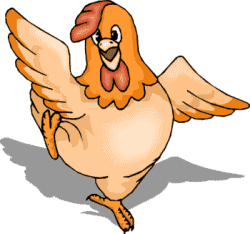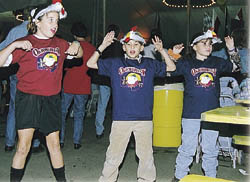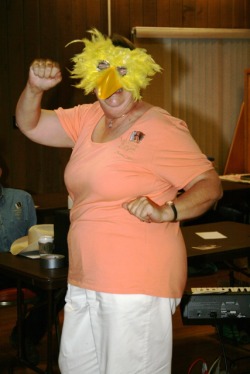The Chicken Dance

Who hasn’t heard of the Chicken Dance? The fun tune and the relative simplicity of the dance moves make it a dance that is easy to not only learn but partake in. Everyone looks equally silly when doing the Chicken Dance, diminishing any sort of embarrassment or performance anxiety. As people flutter their wings and shake their tail feathers, group cohesion is created. The silly and sometimes ridiculous movements are what make the dance all the more exciting. No one has to worry about appearance. The dance is all about having fun with the people you are with and being worry-free. There are no rules and no lessons need to be taken to master this dance. It is all of these characteristics which make the Chicken Dance so appealing to the masses. It is for everyone. It is not defined by upper or lower classes nor is it restricted to one generation. Most importantly, it provides people with the opportunity to socialize and really ‘let loose’.

Children participate in the Chicken Dance at Oktoberfest.
Although almost everyone has heard of the Chicken Dance, few people are actually aware of the history behind this popular social dance. Werner Thomas, a Swiss accordion player, composed the tune in the 1950’s. Mr. Thomas began performing “Der Ententanz” or the “Duck Dance” at his restaurant in 1963. People were immediately drawn to the tune and added their own movements to the music, gradually developing the popular tail, wing, and beak motions. The craze spread to Europe when a Belgian music publisher overheard the tune in Mr. Thomas’ restaurant and translated it to his native Dutch language. As the Chicken Dance spread throughout Europe it underwent several name changes some of which included, “"Vogerltanz" (Little Bird Dance or Birdie Dance) and "Kükentanz" (Küken means chicken).
The United States did not become exposed to the Chicken Dance until around the early 1980’s. New York publisher Stanley Mills obtained the U.S. publishing rights and began to relentlessly search for an album to include the tune. He changed the name to “Dance Little Bird” in an attempt to commercialize it and added his own set of lyrics: “Hey, you're in the swing/You're cluckin' like a bird (pluck, pluck, pluck, pluck)/You're flappin' your wings/Don't you feel absurd." The lyrics did not receive the same popular response as the tune, but Mills was able to place the song on several recordings including “Hooked on Polkas!”, a 1982 album by Jimmy Sturr. Pretty soon the “Chicken Dance”, a name which evolved out of its recognition of the dance moves, was being played at Oktoberfests, weddings, and other events. The dance grew exceptionally popular and record labels began asking Mills permission to use the song in record labels. The tune became increasingly popular in commercials as companies showed interest in using the tune to increase appeal for their product. One such commercial was Burger King. The Chicken Dance brought in an income of $7,000 for television commercials in 1995, a number which came to reach and exceed $50,000 in following years. Walt Disney made sure to get a piece of the craze, developing their own version in which Minnie Mouse demonstrated the dance in an effort to teach the moves to younger kids.
The United States did not become exposed to the Chicken Dance until around the early 1980’s. New York publisher Stanley Mills obtained the U.S. publishing rights and began to relentlessly search for an album to include the tune. He changed the name to “Dance Little Bird” in an attempt to commercialize it and added his own set of lyrics: “Hey, you're in the swing/You're cluckin' like a bird (pluck, pluck, pluck, pluck)/You're flappin' your wings/Don't you feel absurd." The lyrics did not receive the same popular response as the tune, but Mills was able to place the song on several recordings including “Hooked on Polkas!”, a 1982 album by Jimmy Sturr. Pretty soon the “Chicken Dance”, a name which evolved out of its recognition of the dance moves, was being played at Oktoberfests, weddings, and other events. The dance grew exceptionally popular and record labels began asking Mills permission to use the song in record labels. The tune became increasingly popular in commercials as companies showed interest in using the tune to increase appeal for their product. One such commercial was Burger King. The Chicken Dance brought in an income of $7,000 for television commercials in 1995, a number which came to reach and exceed $50,000 in following years. Walt Disney made sure to get a piece of the craze, developing their own version in which Minnie Mouse demonstrated the dance in an effort to teach the moves to younger kids.
Originally the Chicken Dance was associated with German heritage. Today it is not strictly defined to one ethnic heritage and is a staple at weddings and Oktoberfests. Some bands will even encourage those at the festival to participate in the dance every hour. The dance moves are basically the same, although some minor variations do exist. Once all of the steps are completed, the same cycle is simply repeated again.
Dance Steps:
- Begin in a circle with everybody facing one another.
- When the music starts, shape your hands like the beak of a chicken and open and close them for four counts.
- Make your arms like the wings of a chicken and act like you are trying to fly for four counts.
- Place your arms and hands like the tail feathers of a chicken and wiggle down for four counts.
- Clap four times.
- Repeat this process four times.
- After the fourth time you grab your neighbors' hands and move in a circle.
- Switch directions on the band leader's command.
("The Chicken Dance." About.com. Real Beer Media Inc., Web. 1 Oct 2009.< http://vetmedicine.about.com/gi/dynamic/offsite.htm?site=http://www.realbeer.com/spotlight/chickendance.html>.)
Dance Steps:
- Begin in a circle with everybody facing one another.
- When the music starts, shape your hands like the beak of a chicken and open and close them for four counts.
- Make your arms like the wings of a chicken and act like you are trying to fly for four counts.
- Place your arms and hands like the tail feathers of a chicken and wiggle down for four counts.
- Clap four times.
- Repeat this process four times.
- After the fourth time you grab your neighbors' hands and move in a circle.
- Switch directions on the band leader's command.
("The Chicken Dance." About.com. Real Beer Media Inc., Web. 1 Oct 2009.< http://vetmedicine.about.com/gi/dynamic/offsite.htm?site=http://www.realbeer.com/spotlight/chickendance.html>.)

I choose to take a deeper look at the origins of the Chicken Dance because it was something that had always intrigued me. Although I am not much of a dancer and have never taken any sort of instruction in dance, I am very well aware of the Chicken Dance and know how to do it. The simplicity was actually one of the things that attracted me most to the dance. I was curious as to how it came about and its purpose. I have been to many weddings where this song has been played and have even danced the Chicken Dance at a couple of birthday parties, especially when I was younger. One thing I find most intriguing about the Chicken Dance is the fact that there is no age barrier. My parents are just as familiar with the dance as I am, something that is not common of most dances.
When I watch or partake in the Chicken Dance I am overcome with this feeling of happiness. It’s as if when doing this silly little dance, all of my worries are stripped away, at least momentarily. I am not worried about making a fool of myself, as everyone else looks just as obscure. The tune is very lighthearted and uplifting. Quite frankly, when I hear or watch the Chicken Dance I feel drawn to it and want to jump out of my chair and partake in it.
My personal experience with the Chicken Dance allows me to see a little glimpse of the creator. I think that Mr. Thomas wanted to create a fun and lighthearted song in which everyone could engage in and enjoy. The tune reflects a sort of optimism the creator possessed. I think Mr. Thomas’ intent was to bring a group of people together. His tune reflects simplicity, allowing any individual to participate in the dance. Mr. Thomas’ composition of this catchy tune resulted in an irresistible phenomenon, as apparent by the continuous popularity of the Chicken Dance today.
When I watch or partake in the Chicken Dance I am overcome with this feeling of happiness. It’s as if when doing this silly little dance, all of my worries are stripped away, at least momentarily. I am not worried about making a fool of myself, as everyone else looks just as obscure. The tune is very lighthearted and uplifting. Quite frankly, when I hear or watch the Chicken Dance I feel drawn to it and want to jump out of my chair and partake in it.
My personal experience with the Chicken Dance allows me to see a little glimpse of the creator. I think that Mr. Thomas wanted to create a fun and lighthearted song in which everyone could engage in and enjoy. The tune reflects a sort of optimism the creator possessed. I think Mr. Thomas’ intent was to bring a group of people together. His tune reflects simplicity, allowing any individual to participate in the dance. Mr. Thomas’ composition of this catchy tune resulted in an irresistible phenomenon, as apparent by the continuous popularity of the Chicken Dance today.
